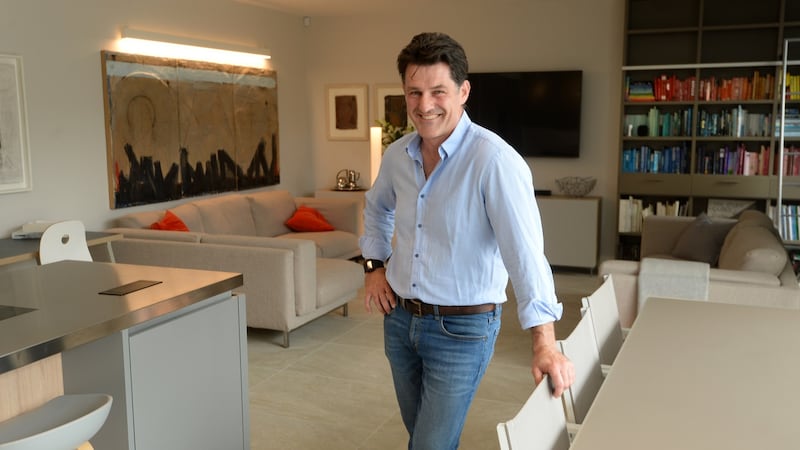Incentivise public-private developments
Fiona Cormican
Clúid Housing not-for-profit charity
Social housing is an essential component of a properly functioning housing market. Mixed tenure communities should be the backbone of housing in Ireland. Since its introduction in 2000, Part V [a mechanism allowing local authorities obtain up to 10 per cent of land zoned for housing development to facilitate the delivery of social and affordable housing] has served to support social integration across all new housing developments in Ireland and has not deterred private buyers as was suggested by some at the time. Legislating for developers to support the delivery of sustainable communities with tenure mix is the way forward. We can achieve this by increasing the percentage of new Part V developments made available for use as social, cost-rental or affordable-purchase housing from 10 per cent to 20 per cent. With the State's first cost rental schemes due for delivery this year, we want to see private, cost-rental and social-rented housing delivered side by side in truly mixed tenure schemes. This will help build sustainable communities and help to end the cycle of stigma.

It is possible to encourage sustainable new supply in partnership with investors without excluding first-time buyers or other low-income households. Incentivising developers to deliver is one solution. Incentivised mixed tenure developments financed by allowing a portion of a scheme to be purchased by investors, in addition to tax incentives for developers if they sell starter homes below a certain price threshold, can enable developers to continue delivering new homes to first-time buyers.
Developing housing is expensive. However, social and cost-rental housing developed by approved housing bodies (AHBs) is a smart investment, with once-off payments making housing available to successive generations in perpetuity. The Government has recognised that AHBs are central to meeting Ireland’s social and affordable housing needs. Together with our Housing Alliance partners, Clúid continues to campaign to reverse the classification of AHBs as on the Government’s balance sheet. With a looming black hole in the public finances, AHBs may find themselves competing for increasingly scarce public resources if reclassification does not happen as soon as possible.
Revitalise neglected city space
Mel Reynolds
Architect
In the last census more than 180,000 vacant homes were recorded nationwide. This figure excluded vacant upper floors in commercial premises and over shops. Looking overhead in every town in Ireland there are vacant floors that could be converted to residential accommodation for a fraction of the cost of new builds. The potential for this neglected space is huge. Even if only one in two vacant units on upper floors is reusable, it would greatly improve residential living options in the city.

Spaces within existing buildings are centrally located, already serviced and can be repurposed easily – and at a fraction of the cost of new builds. Converted upper floors could be suitable for short-term lettings, typically having less outdoor space and no off-street parking. Dublin City Council has the capacity overhead to accommodate AirBnB units while freeing up larger dwellings for longer-term tenure as family homes. Making better use of existing buildings is much better, incurs a lower carbon cost to create and could be twinned with incentives for energy-efficient retrofits.
Barriers exist to this that are mainly down to our processes for statutory permissions, which have evolved historically and in an ad-hoc fashion. But these building control processes could be streamlined by ministerial order immediately to facilitate over the counter “one-stop-shop” permits for fire, disabled access and planning. Costs would be reduced with the implementation of a simple building control inspectorate system similar to that of Northern Ireland (we have this already, it just needs more resources). Similar to in the United States, applicants for internal modifications could queue up at respective counters in local authority offices and get required permissions over the counter.
As stick, increased rates or fines can be imposed for underused or vacant commercial space. As carrot, introduce grants for low energy refurbishments, accelerated capital allowances for refurbishment costs and Capital Gains Tax holidays for a period.
Establish a national housing commission
Marian Finnegan
Residential managing director at Sherry FitzGerald
To solve any problem the first thing that needs to be established is the size of the problem. To this end, to describe the current situation as a housing crisis is simplistic. We have an accommodation crisis, and we need to find a solution for all elements of that crisis.
Having established the scale of the problem we need a set of measurable targets. It seems realistic to me to aim to deliver 30,000 new residential units in 2022. While not sufficient, it would be more than 40 per cent of an increase on the most optimistic forecast for 2021.

To ensure we do not repeat past mistakes, this target then needs to be broken down into tenure type and location. As such we need a starter home target for first-time buyers, a target for rental accommodation, a target for social and affordable homes, a target for trade-up homes and trade-down homes, etc. We then need to combine public and private sector skills to deliver these targets. This would prevent repetition of corrosive debates while bringing society together with a unity of purpose – to deliver a mixed and diverse housing supply.
Having defined the problem and set out clear measurable targets, a national housing commission should be established, working with Government to develop a coherent long-term plan to deliver good-quality, affordable homes for all cohorts in our society.
Despite good intentions, the current governing structure failed to grasp the implications that the population growth recorded in the 2011 census or the macroprudential rules or Brexit would have on the Irish housing market. Let us learn from this and plan now for the necessary changes in housing policy post-Covid.
In short, define the problem, set goals, measure results, and prepare a long-term strategy that is not deviated from by the vagaries of daily events.
Make public and private platforms work towards a common aim
Michael Stanley
Cairn Homes chief executive
To solve this crisis we need all delivery platforms, both public and private, working in parallel. Supply must be encouraged to protect the estimated 1 million people that will either never own a home or will choose not to, in favour of long-term, secure rental.
Cairn’s primary focus is to provide well-constructed family homes for people who want to own at prices where they can get access to mortgage finance. A typical Cairn customer is a couple in their late 30s, many with young families, whose ambition is to buy a good first home in an urban or suburban neighbourhood close to amenities and transport links.

Unless customers are on a minimum single or combined salary of €90,000, they have little prospect of achieving this. This is one of the reasons why only 12 per cent of people between the ages of 25 and 39 in Ireland own their home.
There are many influencing factors at play that impact supply and affordability in the Irish market. Here are two of the significant barriers that exist:
Every first-time buyer in Ireland pays a staggering €7,500 to Ervia for a water connection to their new home. In the UK, the charge is £1,100 (€1,278). In effect, new homeowners subsidise existing homeowners when it comes to water charges. In addition, new homeowners also pay a levy of €1,100 to become a lifetime customer of the ESB.
The second example concerns the Central Bank’s macroprudential rules on lending, which, in five years, have not fundamentally changed to respond to a changing environment, with both marginal tax rates and mortgage interest rates lower.
The 3.5 times loan-to-income multiple is restricting this generation of buyers and means that in many areas in Ireland, people earning under €90,000 are prevented from owning a home.
These are but two examples of the many influencing factors at play that directly impact supply and affordability in the Irish market.
What we need is for each market constituent to work in parallel towards a common aim. Name calling, demonising and the political blame game makes an achievable solution all the more challenging.
Government should commit to buy homes from private builders
Dermot O'Leary
Goodbody Stockbrokers chief economist
Be very sceptical of a government that promises quick fixes when it comes to housing. Getting housing right is a hard slog, involving an array of actors from areas such as planning, infrastructure, the environment and finance, to name but a few. A stable housing system requires long-term policies that go beyond the electoral cycle. For the last 40 years, Ireland has not had a proper long-term housing strategy, so is it any surprise that it has experienced among the most severe housing cycles in the developed world?

A commission on housing, promised in the Programme for Government, is meant to result in such a long-term policy being agreed across the political spectrum. Government needs to prioritise getting the commission off the ground so that relevant stakeholders can be consulted, and best international practice employed in concluding a long-term strategy.
Shorter-term measures should recognise that the private and public sectors need to work together. While the recent focus has been on how investment funds have been buying from under the noses of first-time buyers, data shows the State has been an even bigger culprit; latest data for 2019 shows 20 per cent of new homes were purchased by the public sector, while only 7 per cent were purchased by the real estate and finance sector. Long-term leasing has increased this demand further.
In some cases, councils and approved housing bodies are in direct competition for new homes with the private sector. Given that the Government’s need for new homes will remain high for the foreseeable future, a better model would be for the Government to forward commit to purchase homes from the private sector, through a competitive procurement process, for the next number of years. By setting out a long-term agreement, the Government can reduce market risk for the builder, thereby making it easier to access finance and addressing the issue of scaling up to meet a housing demand that is well in excess of current levels of supply for the coming years.
Get out and explore the type of housing society really wants
Lorcan Sirr
Technological University Dublin senior planning and housing lecturer
Irish housing policy is severely lacking vision. It has no concept of the type of housing system we aspire to, need or can afford. We have plans aplenty, and another one imminent. But as Nelson Mandela said: "Action without vision just passes the time."

Back when Fianna Fáil and Fine Gael housed people on modest incomes by the hundreds of thousands, the main policy-driver was the achievement of social goals. Nowadays, the main policy-driver is the achievement of financial goals, and not always those of the State. And what has it achieved? Shameful amounts of homelessness, a lack of affordable housing, forced car ownership, increased commuting distances and times, a hollowed-out city centre given over to investment funds, tourists and well-paid tech workers.
It’s time to switch up what drives policy. Part of the problem is the people ministers take their advice from. There is a tendency to listen to “people like us” about what housing should be like for “people like them”.
We then get people living in low-rise developments promoting expensive high-rise; lobbyists who own their own homes advocating long-term renting; self-appointed experts who live in large houses lobbying for smaller housing; and those with no mortgages (half of all homeowners) happy to load first-time buyers with more debt through various government schemes to buy seriously unaffordable houses.
Policy makers need to get out more and away from the echo chamber of “people like us” in order to understand the type of housing society really wants. If the Minister is brave enough to ask, the answer probably won’t be expensive investment fund rentals or co-living.



















